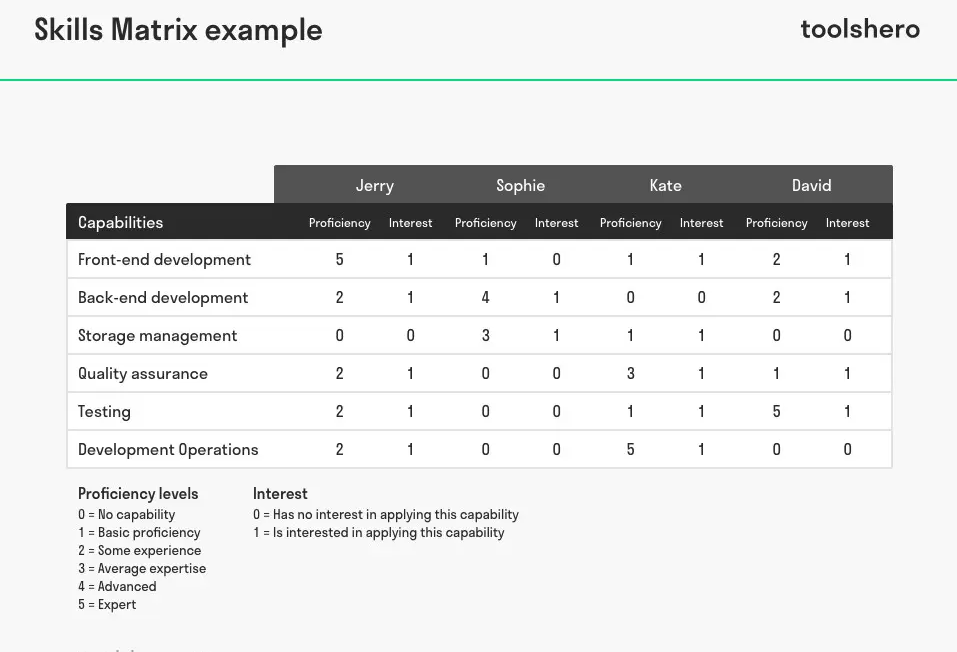What is a skills matrix?
A skills matrix is a framework for mapping the abilities and levels of employees. It is a grid or visual representation with information about available skills and competencies and how they are rated. As a result, it is a must-have for every individual employee e.g. a data-driven HR practitioner, working with a customer requires not only technical skills such as programming and data analysis, but also teamwork and communication are required soft skills for a Software Engineer.
A skills matrix is also known as a competency matrix. It is used to manage, plan, and track existing he desired skill vs current skill for a certain function, team, department, project, or firm.
A skill matrix is a simple table that lists the names of employees and their skills i.e. an employee skills matrix. A completed competency matrix depicts the necessary skills, those present in the team, and those lacking. This is where the skill gap exists. Thus, it can help managers identify skills gaps within teams and fill them with other internal current employees with relevant skills.
The matrix can be divided into specific job roles within a project, or it might show all talents required to fulfill every aspect of the project. Each team member is often given a rating based on their skill competency and desire in acquiring and use a specific talent. This enables leaders to properly distribute jobs to team members who desire to use their relevant skills for the work and successfully finish it. It enables the leaders to fully utilise their key players in projects who will deliver above-average value.
The Skills Matrix, when used appropriately, provides a reliable overview of a teams knowledge and skills. It can tell you if you have the essential skills to complete certain activities. A skills gap occurs when a team is missing certain relevant skills. As a result, it is a must-have tool for any human resource manager who makes decisions based on data.

The above image shows a skill matrix example by toolshero which can be used as a skills matrix template.
Advertisment
Benefits of the skills matrix
The development of a skill matrix is critical because it focuses on discussions on how work is accomplished and the fundamental abilities required to execute the jobs that contribute to the work in each department. Both individuals and businesses must be aware of what skills and competencies are available on the job at any given time. A skills matrix is an excellent tool for gaining a better understanding of various key skills and the levels of competency required. Thorough knowledge of the desired areas of growth and where they need to focus their training efforts can be discovered from the skills gaps observed from the skills matrix.
1. Determine which skills are lacking
Skills matrices can assist you to figure out what skill sets are lacking in your team, department, or firm as a whole.
If your employees lack critical business-critical information or skills, and your competitors do, your organization will be at a significant disadvantage.
Its also easier to prepare for, meet deadlines, and accomplish effective results when you know what skill set youll need to start a new project, campaign, or business.
A competency matrix can highlight team members the strengths of the group as a whole as well as the areas where they are deficient in current skill levels and expertise.
2. Recruitment & Hiring
Identify skill gaps and strengths at a team or organizational level in a matter of seconds. This information can be utilized to support judgments about the present state of the company skill landscape and the investment and justification for hiring a specific skill set now or in the future.
Using a skills matrix with a list of skills required, it makes it easier to figure out what skill set youve lost and who you need to hire if someone quits your company.
It streamlines the hiring process and assists the HR department in hiring employees with the necessary abilities, resulting in a more efficient procedure and a better end product.
It can also be used to plan for new hires in the future - both for employee training and job training.
3. Learning & Training
Obtain a baseline of peoples or teams abilities and competencies across the organization. Use this visualization to see people with similar skill levels and to create pathways for them to complete courses and learnings in order to increase their skill set over time. This will also assist in determining the additional training and training opportunities required in the different roles.
4. Workforce planning
Visualize the existing skill mix of project teams to evaluate if it satisfies a client brief and make sure the skill set is in place to provide value to customers and generate income.
5. Employee Experience / Internal Mobility
Allow folks to see how they stack up against their peers. Make sure they fulfil the competency goals you establish and provide them the opportunity to join different teams that match their skill set and identify coaches and mentors who are knowledgeable in specific areas.
6. Qualified replacements & peak period planning
Every business must deal with employees on sick leave or periods of high demand. Its critical to maintain continuity and productivity during times like this by responding swiftly and efficiently. It doesn't take much imagination to see how much easier planning becomes when you can identify who is qualified and who isn't at a look.
When a critical staff member falls sick, a skills matrix is an excellent tool for locating a substitute with the proper knowledge or for ramping up staffing levels ahead of peak output by shifting skilled individuals from one area to another.
7. Monitoring of the progress
When you keep your skills matrices in good shape, they'll provide you with a clear image of how far you've come as a team and as an individual. Professional development, productivity, and the number of skills learned and mastered are all critical organizational challenges. As a result, skills matrices can be used to evaluate the efficiency of your training programs. Furthermore, they highlight precisely where any potential skill gaps exist or are developing.
8. Critical Employees
Every organization has a few most valuable players or essential players that have unique talents and provide above-average worth. In an ideal world, you wouldn't want to lose these employees. Its a lot easier to figure out who these people are when you use skills matrices. You can see who has which talents and qualifications at a glance.
Its simple to locate the individuals in your firm who have the most valuable skillset and follow the progress of key people using a competency matrix. These are essential personnel, and its important to know who they are and whether or not they're happy.
It can also be used to identify employees for promotion and appreciation.
9. Enhanced clarity
Skills matrices give your staff a better understanding of the responsibilities they play in your company. What exactly is expected of them? What can they study or must they learn in order to improve their performance? What professional development opportunities are there for them to advance their careers? Matrices show which skills and abilities are required for a certain job or role. They're a snapshot of where your staff is currently and where there are prospects for advancement. Giving your employees a clear understanding of the value they bring to the table can greatly improve employee happiness and motivation.
10. Increased openness
Transparency in terms of abilities and competencies benefits everyone involved. Transparency is something that skills matrices provide. Who brings what abilities to the company, what skills are found in certain teams, and what attributes do employees possess? Everyone can see where they fit within the overall organization and what it takes to perform a specific function within a team to their full potential.
11. Clear development paths
Skills matrices help to clarify which talents are required for a certain job or role, but they can also be used to map out career routes and professional development programs. Employees can define learning objectives and arrange training programs for themselves more effectively and efficiently if they can detect where potential skills and competency gaps exist within a business. They also disclose the entire range of the organizations growth potential.
12. Stress and workload are reduced.
When a team member is unwell or missing for a lengthy period, workloads can quickly become burdensome. Skills matrices, on the other hand, can be used to predict and mitigate this. With a comprehensive picture of who has what talents, you can strategically reassign resources from team to team or department to department to keep stress and workloads under control. This will also contribute to maintaining a pleasant and stress-free workplace.
